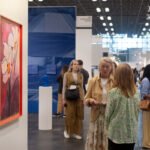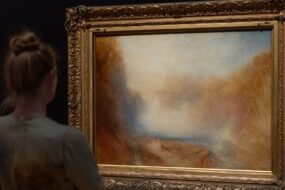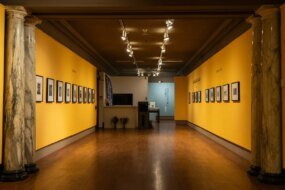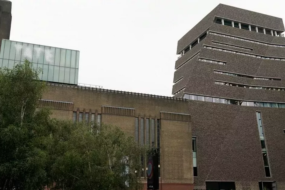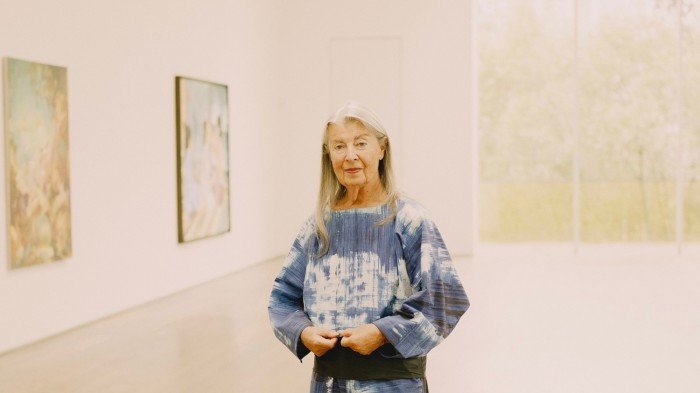
“I used to put things in the window of my husband’s office. People would come in and say: ‘Oh, that’s very interesting — how much is it?’ Then I started doing pop-ups!”
Art dealer Victoria Miro smiles at the memory of her first, humble displays. Soon, she says, she was “really hooked on making exhibitions”.
Today, in a navy blazer and fashionably floppy trousers, her silvery-blonde hair falling either side of tanned cheeks, Miro — who turns 80 next month — looks too polished to have ever been “hooked” on anything. But appearances are deceptive. The elegant outfit comes “from Zara on Oxford Street”. And exhibition-making is indeed Miro’s forte.
This year, Miro’s eponymous gallery is celebrating its 40th anniversary. In the intervening decades, she has presided over a roster of acclaimed artists including Chris Ofili, who won the Turner Prize in 1998 and represented Britain at the Venice Biennale in 2003; Isaac Julien, who enjoyed an acclaimed show at Tate Britain in 2023, and Do Ho Suh, who is currently exhibiting at Tate Modern. Yet despite her prestige Miro remains, as long-term Miro painter Chantal Joffe puts it, “a mysterious person”.
Rarely giving interviews, Miro exudes a shy warmth unusual in a profession inhabited by characters who are self-assured to a fault. Our precious chat is an occasion to lay some myths to rest. It’s been said, for example, that Miro’s father was a Covent Garden market stallholder. In truth, he “worked for a wholesaler”, explains Miro, adding that he was friendly with opera singers and dancers including Margot Fonteyn. Overall her “modest family” was “into the arts” and especially loved music.

From childhood, Miro herself was “addicted to painting”, in part thanks to family holidays in Italy that introduced her to the Renaissance masters.
Her own wares are of a more contemporary ilk. As we talk in her gallery near Old Street — of which more later — we are in the company of a sumptuous painting of a mother and child encircled by gestural motifs by Kudzanai-Violet Hwami; a brooding ink-jet print of a theatre lit by a single diaphanous bulb by Stan Douglas; and a Grayson Perry pot entitled “Forty Years of Art Trends in a Palatable Form” (2025) inscribed with provocations such as “glossy kitsch as cutting edge” and “chilly sculptures made by technicians”.
That constellation is part of Victoria Miro: 40 Years, a scintillating array of works by the gallery’s artists mounted to celebrate its birthday.
Originally, Miro planned to be a painter. But a stint at the Slade proved unhappy. “I found it very academic. I was inhibited.” Was it sexist? “I got the feeling they hadn’t chosen me for my work.”

As all “the excitement disappeared” from her own painting, Miro took a teacher training degree. But her first love lingered. Haunting private galleries since she was a teenager — museums were too “grand and restricted” — she started those pop-up forays.
Their success prompted her to take on her own gallery in 1985 — in Cork Street, no less. As a woman in a “heavily male-dominated” scene, she faced “a great deal of negativity.” However, she was part of a shift away from this misogyny with other trailblazers including Maureen Paley, who had opened her East End gallery the previous year, and Nicola Jacobs, who was already in Cork Street.
“The space had an elevated floor so when people peered in from the street it was almost a theatre,” Miro says of what drew her to that first gallery. One of those window-shoppers was Francis Bacon. “He used to press that wonderful face up against the glass.” She squidges her cheeks together in a goofy expression.
In 1993, she showed Disasters of War, in which Goya’s harrowing etchings were recreated as miniature sculptures by Jake and Dinos Chapman (the former was working for Miro as a technician and very occasionally a babysitter). Sold to the Tate, the work helped usher the Chapmans and Miro into what she calls “a golden age” of British art that witnessed not only the frenzy around the YBAs but also the births of Tate Modern in 2000 and Frieze Art Fair in 2003.
In 2000, nudged by her artists, Miro moved to her current kingdom in a former Victorian furniture factory on Wharf Road. Since then she has expanded next door. (She is keen to credit her husband, Warren, a lawyer, with designing “these wonderful spaces that have made such a difference to me”.)
Airy, light-filled galleries define the Wharf Road site today. But the original building was an “untouched shell . . . a rough, rough space with no nice walls” — catnip to Miro’s artists who wanted “somewhere they could play around.” It was inaugurated with a group show called Raw.
Yet no one doubted the gravitas of “The Upper Room”, Ofili’s 2002 installation of 13 paintings of rhesus macaque monkeys. Their effervescent tranquility riffed on the violent humanity simmering within paintings of The Last Supper. “People would sit there and meditate,” Miro recalls, awed to this day.
Tate bought “The Upper Room” but the deal caused a conflict-of-interest scandal because Ofili was a trustee of Tate at the time. Tate was censured by the Charity Commission yet Miro, who raised money to top up Tate’s budget through private benefactors, escaped relatively unscathed, despite — or perhaps because of — leaked emails showing how ferociously she cut a deal.

Her most valuable gift is self-knowledge. Although she now presides over a team of 63 staff, including, since 1997, her business partner Glenn Scott-Wright — “he’s brilliant, he loves travelling, he’s good with artists” — her passion for making shows has never wavered.
“I just love installing . . . That is the high point.” She pauses, intent as a cat poised to strike. “I like the feeling that you have to get it right.”
Her commitment to their work underpins her artists’ faith in her. Joffe tells me that she loves the way Miro will drop in to her studio, “sit down, look at the work and talk . . . There’s longevity and intimacy.”
Permission to let artists go off on what Joffe dubs “mad tangents” is one of Miro’s virtues. It’s essential, opines the dealer, that artists “go their own way” and not make a show the gallery will be “pleased with”.
What persuades her to take on new talent? Miro ponders. “It’s got to open your eyes to something you don’t know. It’s got to slightly jolt you. Don’t take on work that you think looks nice!” Joffe’s early work “captivated me immediately. The tiny works with their vivid and fearless brushstrokes made me stop and look.”

From the luminous reticence of 20th-century painter Milton Avery — whose estate she represents — to the disconcerting exactitude with which Miro’s latest arrival, Saskia Colwell, conjures the female body in chalk and charcoal on vellum, Miro has maintained her eye for artists animated by a deep interiority.
Although many artists stay with her for decades, she admits forlornly she is “not always right” and must occasionally let an artist go. If they choose to move on, she struggles. “I’m not very resilient. I’m quite emotional . . . but you get over it.”
That sensitivity has also kept her relatively local compared to her multinational peers. “I couldn’t have coped,” she says. “The idea of being on planes all the time. . .” If she were to emulate other galleries’ grandiose ambitions, “the gallery would lose something”. As for art fairs, she participates but describes them as “time-consuming, mind-consuming and team-consuming”.
After opening a space in Mayfair in 2013 — its lease ended as Covid began and was never renewed — today she has just one outpost: a bewitching, canalside time-capsule in a calle behind Piazza San Marco in Venice. As for the future, Miro’s vision is spare: “To keep making strong exhibitions and to nurture my team.”
Hopefully, her son Oliver will don her mantle. The creator of the Vortic virtual-exhibition app, he has “been with the gallery a long time”. Oliver, meanwhile, thinks his 11-year-old daughter Jessica “has the right sensibility” to be next in line to the throne. If the past 40 years are anything to go by, those succession plans will flow extremely smoothly.

To August 1, victoria-miro.com
Find out about our latest stories first — follow FT Weekend on Instagram, Bluesky and X, and sign up to receive the FT Weekend newsletter every Saturday morning




